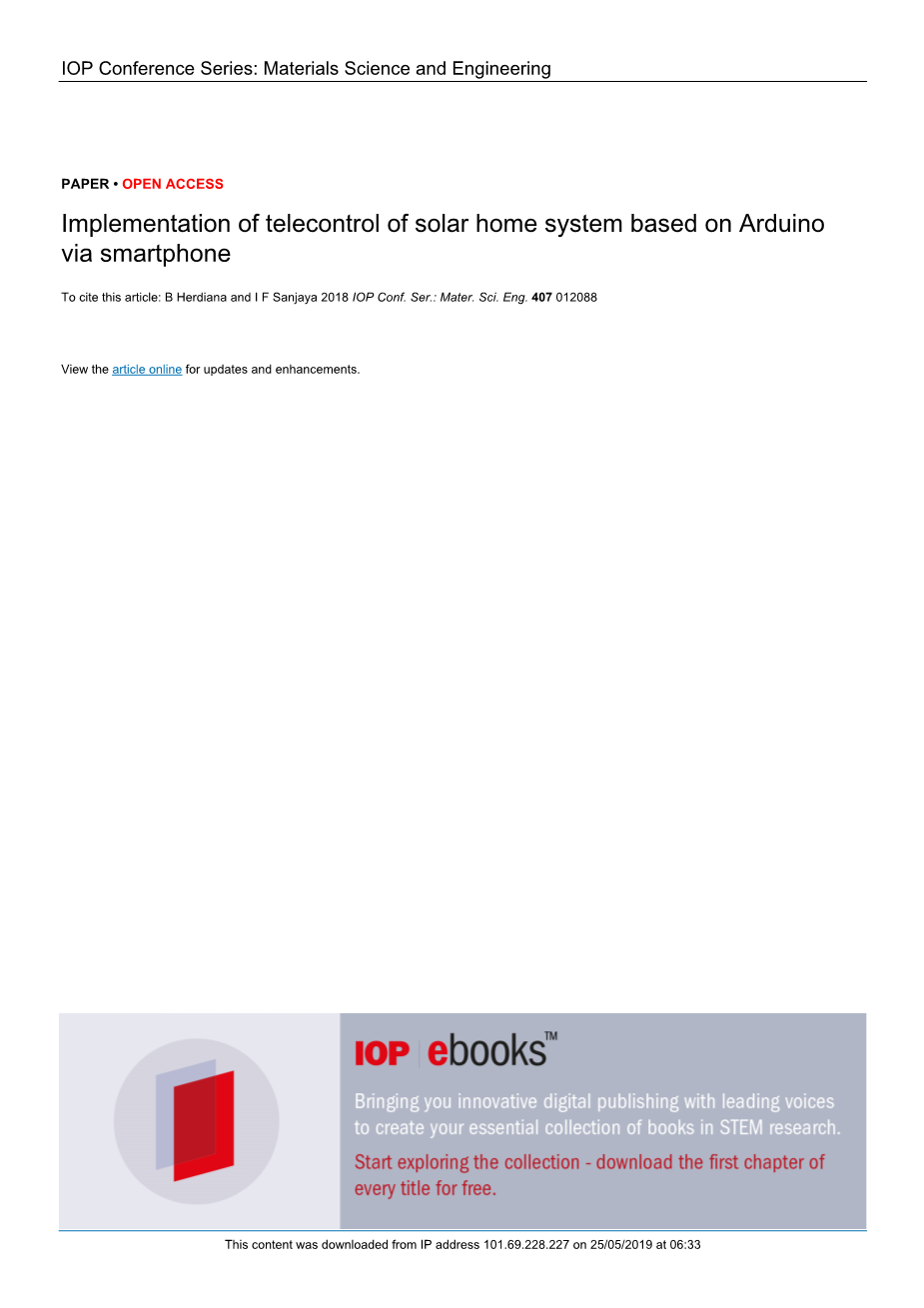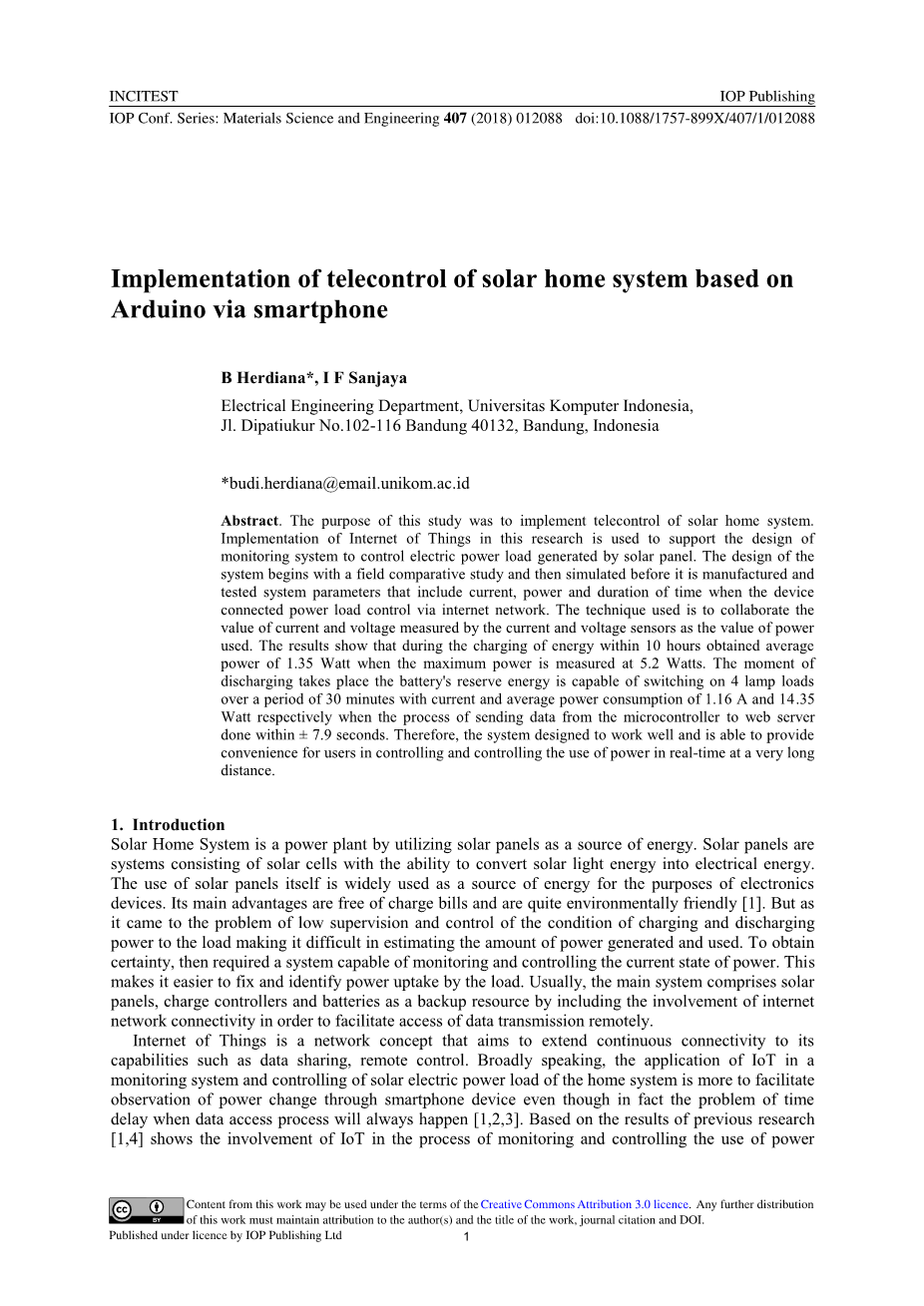基于单片机的室内空气质量检测及控制系统外文翻译资料
2023-01-08 11:35:02
本科毕业设计(论文)
外文翻译
《Implementation of telecontrol of solar home system based on Arduino via smartphone》
作者:B Herdiana ;I F Sanjaya
国籍:Indonesia
出处:Universitas Komputer Indonesia
原文正文:
Abstract
The purpose of this study was to implement telecontrol of solar home system. Implementation of Internet of Things in this research is used to support the design of monitoring system to control electric power load generated by solar panel. The design of the system begins with a field comparative study and then simulated before it is manufactured and tested system parameters that include current, power and duration of time when the device connected power load control via internet network. The technique used is to collaborate the value of current and voltage measured by the current and voltage sensors as the value of power used. The results show that during the charging of energy within 10 hours obtained average power of 1.35 Watt when the maximum power is measured at 5.2 Watts. The moment of discharging takes place the batterys reserve energy is capable of switching on 4 lamp loads over a period of 30 minutes with current and average power consumption of 1.16 A and 14.35 Watt respectively when the process of sending data from the microcontroller to web server done within plusmn; 7.9 seconds. Therefore, the system designed to work well and is able to provide convenience for users in controlling and controlling the use of power in real-time at a very long distance.
1.Introduction
Solar Home System is a power plant by utilizing solar panels as a source of energy. Solar panels are systems consisting of solar cells with the ability to convert solar light energy into electrical energy. The use of solar panels itself is widely used as a source of energy for the purposes of electronics devices. Its main advantages are free of charge bills and are quite environmentally friendly [1]. But as it came to the problem of low supervision and control of the condition of charging and discharging power to the load making it difficult in estimating the amount of power generated and used. To obtain certainty, then required a system capable of monitoring and controlling the current state of power. This makes it easier to fix and identify power uptake by the load. Usually, the main system comprises solar panels, charge controllers and batteries as a backup resource by including the involvement of internet network connectivity in order to facilitate access of data transmission remotely.
Internet of Things is a network concept that aims to extend continuous connectivity to its capabilities such as data sharing, remote control. Broadly speaking, the application of IoT in a monitoring system and controlling of solar electric power load of the home system is more to facilitate observation of power change through smartphone device even though in fact the problem of time delay when data access process will always happen [1,2,3]. Based on the results of previous research [1,4] shows the involvement of IoT in the process of monitoring and controlling the use of powerloads by solar panels. But the fact is there is a shortage of research [4] that display data information is only stored on the SD card and LCD with time delay data transmission by 1 minute. While in the study
more to the absence of backup power storage system when the intensity of sunlight is not detected solar panels. Another shortcoming is also seen when the system of supervision and control cannot be integrated with smartphone devices. The focus of this research is to fix these weaknesses and develop them by adding login and password features as protection against system security on smartphone devices.
2.Research methods
The method approach in this research is a quantitative approach because the final result is presented in the form of numbers by involving the corresponding mathematical formula. The stage begins the process of collecting information data related parameters to be tested and measured which refers to the results of field observation data, literature studies, component studies including current, voltage, power and control system testing through IoT connection via smartphone. The next step is to design the system model through simulation comparative approach with hardware for the purpose of testing the conformity of measured parameters before it will be fabricated into a viable device.
The system designed is a monitoring system and load controlled solar home system or a solar power plant for housing aims to facilitate users in managing the power consumption used so that users can maximize the use of solar home systems efficiently.
2.1Block diagram
By block diagram monitoring system and load power usage controller on a solar home system via IoT based smartphone described as in figure 1.
2.2 Hardware design
The design of monitoring system is composed of two sensors that are current and voltage sensors connected to the solar panel where the microcontroller is functioned to process the value of the current and voltage of the sensor which is then informed to the smartphone device through internet network access. The design of the circuit is shown as in Figure 4. (a)
剩余内容已隐藏,支付完成后下载完整资料


英语原文共 8 页,剩余内容已隐藏,支付完成后下载完整资料
资料编号:[272267],资料为PDF文档或Word文档,PDF文档可免费转换为Word




